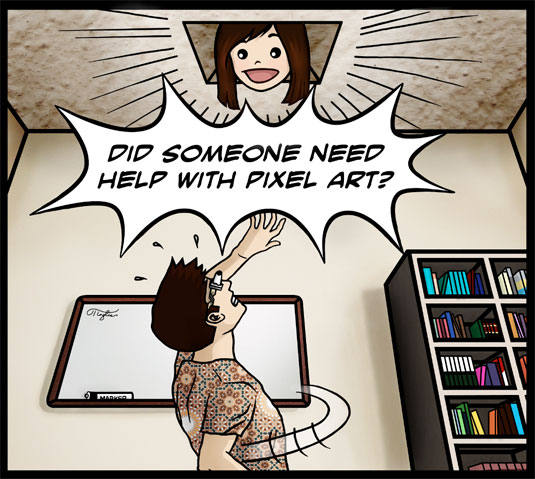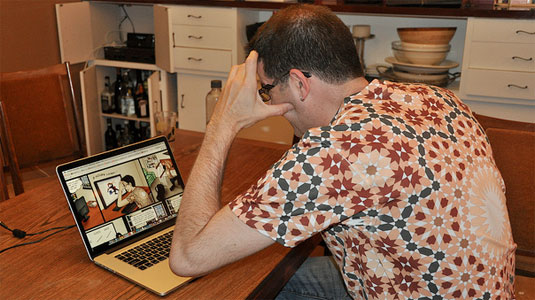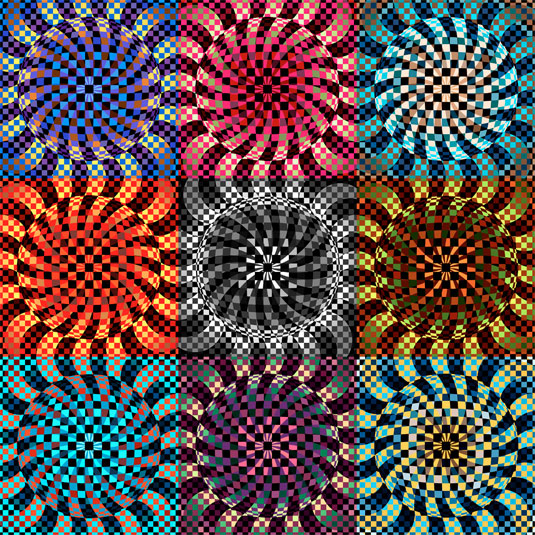

PhD student Tiffany C. Inglis' comic research poster received the prize for best student research at SIGGRAPH 2012 and advanced to the ACM Student Research Competition. CREDIT: Tiffany Inglis
(VANCOUVER) A gifted artist and mathematician, Tiffany C. Inglis only recently came to combine the two interests in graduate school.
During her master’s degree in computational mathematics at the University of Waterloo, she began playing around with ways to create pixel-like art from logic puzzles such as Paint by Numbers, where players decode rows and columns of numbers to reveal a simple image. While designing a similar game based on the Sudoku puzzle, Inglis discovered some interesting challenges in creating such low-resolution images.
“It was difficult to design such puzzles because low-resolution, yet clearly readable images are needed. It was then that I decided to take a closer look at pixel art.”
Finding a lack of research in this area, she decided to focus her PhD thesis on developing an algorithm to convert vector images into elegant pixel art. Now in GRAND’s AESTHVIS project, Inglis is working with supervisor Dr. Craig Kaplan at Waterloo’s Computer Graphics Lab, and her research is gaining high-profile recognition.
In 2012, Inglis placed first at the ACM Student Research Competition (SRC) for her "Pixelating Vector Line Art" poster submission at ACM SIGGRAPH in Los Angeles. The SRC is an internationally recognized venue for undergraduate and graduate students to present their original research before a panel of judges and attendees.
Earlier this year, Inglis went on to place second in the 2013 Graduate Category for the Grand Finals – the ACM’s comprehensive student competition for winners from the all of the SRCs held in the previous year.
“Tiffany's creative approach to research extends to the way she disseminates her results,” said Kaplan. “[The ACM SRC award is] a tremendous and much deserved honour.”
Comic strip poster presents research in a story
As though lifted from a graphic novel, Inglis’ winning submission is a creative and talented reworking of the traditional scholarly poster. Using herself and supervisor Kaplan as characters, Inglis presents her research in a short, smart narrative. A similar poster was also created the 2011 SIGGRAPH conference.
“The way academic posters are usually laid out does not suggest any sort of logical reading order. I wanted to tell my research like a story.”
Inglis presented her award-winning poster at GRAND 2013 in May. Though her first GRAND presentation, she has been actively involved in the planning and organization of annual conferences over the past three years, and was the Research Notes Co-Chair for 2013.
“GRAND has given me opportunities to see what other research is going on. Even within the Aesthetics and Visualization group there is a good deal of interesting work.”

Waterloo Computer Science Professor Dr. Craig Kaplan shown wearing a t-shirt inspired by his depiction in Inglis' award-winning poster, and printed with a pattern he designed. CREDIT: Nathalie Nasr
Pixel art: reinventing rasterization
Pixel art is digital art created pixel-by-pixel. Though the genre might seem a reversion to the bygone days of low-resolution graphics on older console computers and mobile phones, pixel art has developed its own aesthetic movement, especially for those nostalgic for the old 8-bit games. Inglis found that pixel artists challenge themselves intellectually and creatively through the constraint of limited pixels.
She also points out that digital displays still require pixels as the fundamental building blocks of digital images – even for vector images. Unlike raster images that are composed of pixels, vector graphics define objects using geometric shapes like lines and circles. This allows us to zoom into vector images without losing any detail. Pixel art, on the other hand, become pixelated as it gets magnified.
“With pixel art being so closely related to rasterization - a fundamental problem in computer graphics - you'd expect much research done in this area, but even professional pixel artists still work pixel by pixel with very little automation.”
Inglis has been looking at the creative process of artists to pinpoint the rules for good pixel placement. Her algorithms for rendering pixel art attempt to encode these rules in software (for example, rules on how to improve the look of curves at low resolution).
“When we’re drawing, we are basically following a set of rules. I just needed to articulate that and feed it into the computer so it can do the same.”
Using vector outlines as the input image, Inglis’ SuperPixelator application creates low-resolution images that are aesthetically preferable to those generated by other applications, such as Adobe’s Photoshop and Illustrator – a finding Inglis confirmed through a user study. With further work, she envisions her algorithms providing non-artists with tools to create better pixel art.
“It would be particularly helpful for game developers who want to create their own [digital] art but don’t have that much training. The algorithm would help them create pixel art without having to make low-level decisions for individual pixels.”
“Tiffany's research is a wonderful blend of computer science, art, and human perception,” said Kaplan. “She studies rasterization, one of the oldest algorithms in computer graphics. We usually think of rasterization as a solved problem, but in the world of pixel art, where artists think carefully about every pixel in a composition, all sorts of new aesthetic subtleties come into play. Tiffany is reinventing rasterization, developing new algorithms that operate robustly under the extreme constraints of pixel art.”
Mathematical art presented at Bridges 2012
Through her algorithmic approach, Inglis’ has generated a stunning collection of computer art. Her Nine Suns was featured on the cover of the Mathematical Association of America newsmagazine MAA Focus. The geometric mosaic was among her artworks exhibited at the Math Art Exhibition during the Bridges 2012 Conference, the largest mathematics and art interdisciplinary conference in the world. (On a side note, GRAND is a sponsor for the upcoming 2013 Bridges conference.)
It was her supervisor Dr. Kaplan who introduced Inglis to the Bridges conference, and to use her artistic talents in creating her poster. His work in mathematical art also motivated her to apply to the program.
“Craig encourages creativity, [and] our lab encourages creative development,” said Inglis. “I was inspired to learn 3D modelling and creating comics, and I've been submitting papers to Bridges every year as my side project.”
Inglis is expecting to graduate later in 2013 and is looking at potential post-doc opportunities to continue her research.

"Nine Suns" by Tiffany Inglis was presented at the Bridges Art Exhibition 2012 and featured on the cover of the Oct/Nov 2012 Issue of MAA FOCUS. CREDIT: Tiffany Inglis
-30-